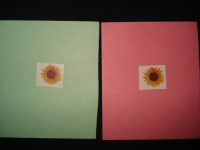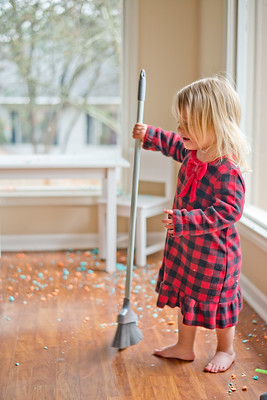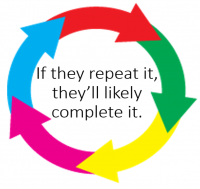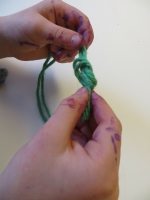Find many creative ideas to get children leaping ahead in their physical development, all while done with things found at home. This is the time to take a minute to watch these and strengthen your options while stuck at home. Enjoy!
Kirby reminisces fondly about her mom being the only parent who got out and played with the neighborhood kids. Kirby followed in her footsteps. The kids noticed. "You like being with us!"
Outdoor play can be for parents and children. It's really important to play outside with kids, not just to send them out and invite neighborhood kids over. Their development will leap ahead -- socially, cognitively, physically, relationally (especially toward the parent playing with them).
But you may not have had an experience like Kirby's. And if you have not seen it modeled, you may not be able to picture it.
Anything can be made into a matching game. Just look around your house. Do you have two forks? Two noodles? The point is, you don't have to go out and buy anything to make a matching game.
In matching, the brain is being wired in both pre-math and pre-reading ways to notice what's alike and what's different. For example, how does a child learn to differentiate between an "a" and a "d"? They need to see all the parts of something before they decide if they are the same or different.
So, starting when children are toddlers, begin to simply notice and name the difference in things. Big rock, small rock. Two different leaves. You can mention similarities as well. Then point out the differences. Two different balls. Mention size, color, etc. This is the first step. Just notice and point out things that are the same and different in everyday life.
Here are two learning games that can be done while going about normal everyday tasks that will involve children age two or older in growing developmentally all while getting things done!
ORDER GAME
Materials:
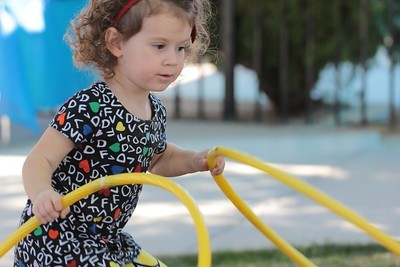 How to Use a Hoop:
How to Use a Hoop:
- Place the hoop on the floor, one for each person (including parents), and take turns telling each other how many body parts to put into your hoop. Be creative: elbow and knee, bottom and two hands, etc….any two body parts. This aids in learning inside/outside and number of parts. (Parents/grandparents: only do what you can safely do. If you have any concerns, check with your doctor.)
- Kukla is a Turkish game most commonly played by making an O in the dirt and piling up rocks in the center. This can also be played indoors with a hoop and homemade bowling pins or a pile of blocks inside the hoop. Once the pile is set, use bean bags or rolled up socks (socks are one of the safest indoor balls) to throw and knock it down. If anything is knocked down, everyone yells in unison “Kukla!” We celebrate any success, even a slight movement: “Look it moved. You almost got it! Let’s see if you can knock one down this time.”
1. Put pieces of masking tape (approximately the length of the child's foot) : one piece for hopping and two side-by-side pieces for jumping along a path. Wherever you put the two pieces, direct your child to "Jump!" and when they get to the single piece of tape remind them to "Hop."
This course can be as long or short as you like, indoor or outdoor, from the kitchen table to the bathroom to brush teeth after a meal, etc. This activity is growing muscles in your child's body, teaching the ability to balance (especially when hopping), and learning to follow directions is a benefit as well.
Bubble Art
Stage 1: When teaching a child to blow through a straw, have them put it in their mouth and hold their hand at the other end so that they can feel the air come through the straw when they blow out (instead of sucking in).
Stage 2: Since children are more accustomed to sucking in than blowing out, use water in a glass to show the difference. Place the straw in the water and have the child blow bubbles in the water to practice blowing out.
Contributing to the Family
Research that was done years ago came to show that cultures that allow children to participate in the normal activities of the home (e.g. tending to the goats, feeding the chickens) – that is, cultures that value the contribution of the children to the family – see a lot of success from these children in later years. They grow up to have a good work ethic, a higher sense of responsibility, hard-working practices, and a solid self-esteem.
Chores may be a thing of the past in many homes today. There are modern conveniences that one might hope would render chores obsolete – or that’s what the sales people suggest. Or the parents simply need to get things done in the limited amount of time they have in their busy schedules. And let’s face it, some in our generation may resent being made to do chores in our youth and do not wish to “put our kids through that”.
When Kirby Worthington, co-founder of Growth and Giggles, was working toward her Master’s degree, she spent time as a director of a Montessori preschool. She had read research on repetition and decided to test it out. On a very cold winter’s day, after three days of freezing rain and no outside playtime at school, the sun came out and it was time to go outside again. However, under the swing there was a giant mud puddle full of the freezing rain. Before going outside she gathered the children and told them: “We’re going to get to play outside, and you can play on any of the equipment – except no swinging today”, and she explained about the puddle. As they went out the door, she stopped each child asking them, “Where are you NOT playing today?” And they would repeat back to her, “No swinging and no playing in the mud.” Do you know, the experiment worked and not one child broke the rule. She was outside observing their behavior and, sure enough, they had in their minds what to do and what not to do. And they stuck to it.
If they repeat it, they’ll likely complete it.
If you get children to say the rule or expectation, they’ll generally choose to listen to it. (Not always, of course; let’s be realistic!) It helps to have them repeat it the first time. But what really helps is to have them repeat the rule every time you have that expectation of them.
Do you have trouble getting your preschooler to cooperate? (That was a joke…of course you do—they're preschoolers!)
One simple change you can make--without much effort, without discussing parenting philosophy with your spouse, without brainstorming rewards or meting out punishments— can make a significant change in how cooperative your preschooler becomes.
And don't tell, but it will probably work on the adults in your life, too.
If you're looking for a versatile toy with tremendous developmental benefits, a simple length of string, rope, or yarn is the way to go. Here are some games you can play with that string that address various areas of a child's development. Many of these can be played anywhere! Keep yarn or string in your purse or pocket to pull out when your little one is getting bored and needs something fun and challenging to do.
Balance and Coordination String, yarn, or rope makes a perfect balance beam. Stretch the string out on the floor, and show your child how to walk on it, putting one foot in front of the other. Your child can do lots of fun things on a balance beam:
- Walk on a curvy or zigzag line
- Balance on one foot on the string
- Do an arabesque (or scale)
- Jump zigzags back and forth across the string
- Hop on one foot either on the balance beam or from side to side
- Walk backwards
- Do forward rolls
- Walk on tiptoe on the beam
For more ideas, see this post.


